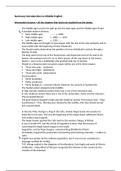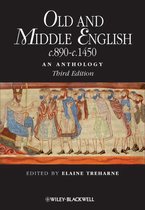Summary Introduction to Middle English
Information lectures + all the chapters that had to be studied from the books:
- The Middle Ages used to be split up into the Dark Ages and the Middle Ages Proper
A possible modern division:
Early middle ages: ….. – c. 1000
High middle ages: c. 1000 – c. 1250
Late middle ages: c. 1250 - …..
- The Middle Ages are thought to have begun with the end of the Late Antiquity and to
have ended with the beginning of Early Modernity.
- The feudal system determines the position of every individual in society through a
division of land.
- The king stood at the top of the feudal chain and dispensed most of his land to his
barens, who passed most of it on to their vassals, all the way down to the manor.
- Manor = was run by a landholder who granted land use to tenants.
- People in a feudal system occupied a place within one of the three estates:
Those who pray (oratores)
Those who fight (bellatores)
Those who work (laboratores)
- Social position:
Partly hereditary
Partly vocational
Partly biological = a woman follows whatever her parents or husband do.
- The feudal system stopped social mobility.
- In high and late medieval society there was a rise of the merchant class.
- In late medieval society there was a rise of the universities, clerks and the chancery.
This increased literacy.
- The government changed in high and late medieval society: from king & God -> king
& parliament -> first, the king was checked by the nobility, that then slowly turned
into a government.
- In the late 440s, Vortigern, king of the Celts, invited Anglo-Saxon mercenaries to
assist him in his wars. This was the beginning of the Anglo-Saxon settlement that is
now modern-day England.
- The Anglo-Saxons pushed the Celts back to the western fringes of Britain.
- It was not until 597, and the arrival of Augustine in Kent, that the process of
converting the Anglo-Saxons began in the south.
- Augustine, sent by Pope Gregory, converted king Ethelberht of Kent.
- Christianity required the production of preaching and teaching materials -> written in
Latin.
English was spoken by the ordinary population, but it was not yet considered a
language suitable for writing.
- 793: Vikings settled in the kingdoms of Northumbria, East Anglia and parts of Mercia
(midlands) -> King Alfred of Wessex recognized this division of the country by the
creation of the Danelaw.
, - It was in Alfred’s reign that Old English was recognized as a language for written
texts.
- The Benedictine reform movement, supported by King Edgar, was crucial in reviving
learning and the production of manuscripts in the 2nd half of the tenth century.
- Comitatus = the lord and his loyal band of warriors.
- In 1066, 5,000 Normans invaded, and between 1066 and 1100 another 20,000
Normans settled in England.
- Crucial aspects of the Norman Conquest = the conqueror placed his men in all
positions of power: church, court, central and local government, local magnates and
as administration:
English ceased to be the language of the monarchy and its related administrative
bodies.
Latin continued in its role as main language of learning and religious writings and
French was used for administration, later law, and the production of literature for
the aristocratic.
- In the last quarter of the 12th century, English was used for the composition of
important, original texts.
- Literacy in the Anglo-Saxon period was confined to relatively few people: those of the
aristocratic stratum of society, and those who chose to enter a monastic or a regular
religious life.
- Manuscripts were costly in terms of labour and resources to produce and only
relatively wealthy individuals or institutions, or educated people, owned or had
access to them.
- Edward the Confessor died childless in 1066, without a successor.
- Harold was killed at the Battle of Hastings, and William was crowned king of England
on Christmas Day 1066.
- William I died, leaving three sons:
Robert Curthose = Duke of Normandy
William Rufus = succeeded father to English throne
Henry = later Henry I
- Henry I married his daughter, Matilda, to Count Geoffrey Plantagenet of Anjou -> son
= Henry II -> started the Angevin dynasty
- By the end of his life, Henry II’s sons were conspiring with Philip of France against him
-> Philip’s goal was the destruction of the Angevin Empire.
- King John (1199-1216) was the least successful member of the Angevin dynasty, a
complete failure, both at war and at home -> at the end of 1205 he had lost all
possessions in Northern France.
- Loss of land incurred the wrath of the baronage and in 1215 the magna carta was
signed.
- The French language dominated in England until the reign of Edward I.
- The High Middle Ages (814-1300) saw the gradual waning of the feudal system in
England and the beginning of towns and burghs.
- In the earlier stages of the development of the towns a class emerged between the
lords and the agricultural workers -> this consisted of large freeholders, certain
tenants, lower nobles and prominent administrators.






